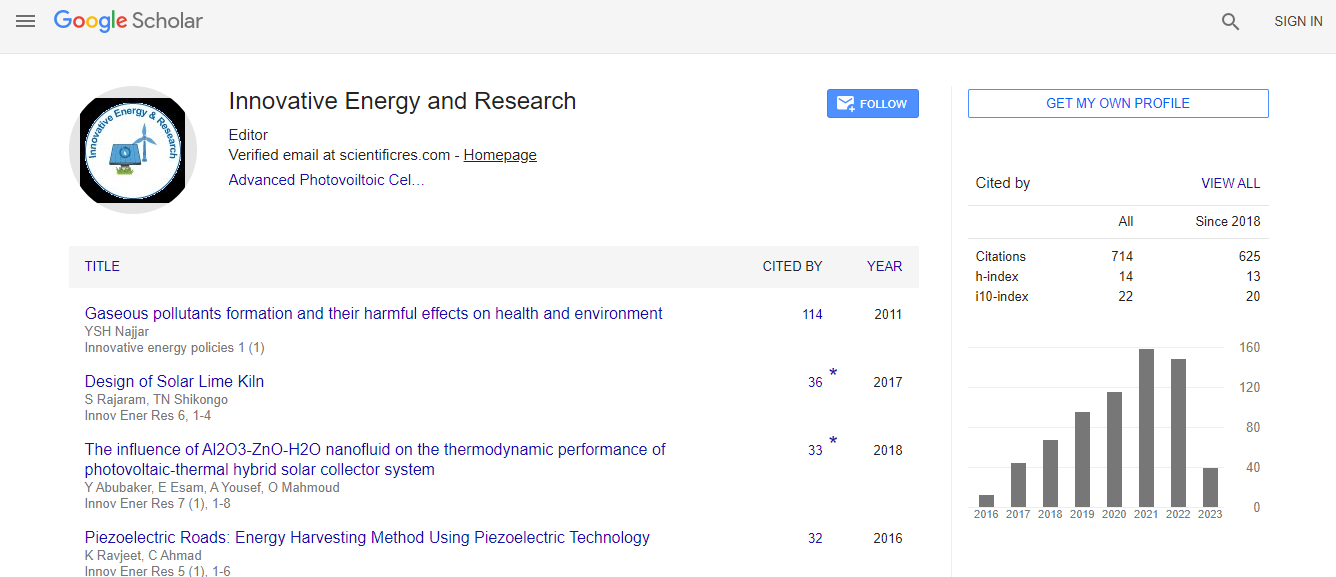Our Group organises 3000+ Global Events every year across USA, Europe & Asia with support from 1000 more scientific Societies and Publishes 700+ ������ Journals which contains over 50000 eminent personalities, reputed scientists as editorial board members.
������ Journals gaining more Readers and Citations
700 Journals and 15,000,000 Readers Each Journal is getting 25,000+ Readers
Citations : 712
Indexed In
- Google Scholar
- Open J Gate
- Genamics JournalSeek
- RefSeek
- Hamdard University
- EBSCO A-Z
- Publons
- Euro Pub
- ICMJE
Useful Links
Recommended Journals
Related Subjects
Share This Page
Highly flexible and scalable photo-rechargeable power unit based on symmetrical nanotube arrays
Joint Event on 2nd International Conference on Renewable Energy and Resources & Energy Materials and Fuel Cell Research
Fayin Zhang, Hongyao Xu and Wenxi Guo
Donghua University, China
Posters & Accepted Abstracts: Innov Ener Res
DOI:
Abstract
Recently, the rapid development of the modern electronics gives rise to higher demands on the flexible and wearable energy resources1–3. It is urgently needed to develop energy devices which are lightweight, thin and flexible. In this regard, these years, many efforts have been made to integrate energy devices by combining solar cells and ESC or repeatedly rechargeable lithium-ion batteries4-7. Up to now, most of the work mainly focuses on the incorporation of a dye-sensitized solar cell (DSSC) with chemical battery power packs which based on different substrate materials and structure design. However, the sealing requirement of the DSSC devices made the fabrication very complex to prevent the electrolyte leakage and evaporation. In addition, the performance of the DSSC still could not meet the ideal requirement of energy storage devices, leading to a low overall energy conversion and storage efficiency. Here, we report an ultrathin flexible photo-charging power pack that integrates a perovskite solar cell (PSC) and electrochemical supercapacitor (ESC) on bi-polar TiO2 nanotube arrays (TNARs)8. Instead of two independent components, the integrated sandwich-type device allows the direct injection of the electrons generated by the PSCs into the ESCs through shared highly ordered bi-polar TNARs. Meanwhile, the holes separated from the perovskite layer divert into a positive electrode of ESCs through an external circuit effectually. When the flexible photo-supercapacitor was illuminated with simulated solar light, the voltage of ESC was increased to 0.63 V within 30 s at the beginning of the charging period immediately. The optimized power pack exhibits a remarkable overall photoelectric conversion (4.9%) and storage efficiency up to 80%, with fast response and superior cycling capability. To meet applicable demands with a larger output voltage, these photo-supercapacitors are successfully woven into “bamboo slip” architecture, which can be folded, bent and allows tuning the open-circuit voltage (> 2.4 V) by charging the number of photo-supercapacitor strips.Biography
Fayin Zhang is a PhD student in the State Key Laboratory for Modification of Chemical Fibers and Polymer Materials, College of Materials Science and Engineering at Donghua University. Now he is an exchange student in the Research Institute for Soft Matter and Biomimetics, Department of Physics, School of Physics and Mechanical & Electrical Engineering at Xiamen University. His research interests include flexible conductive electrode materials, perovskite solar cells and perovskite light emitting diodes.
E-mail: 1152027@mail.dhu.edu.cn

